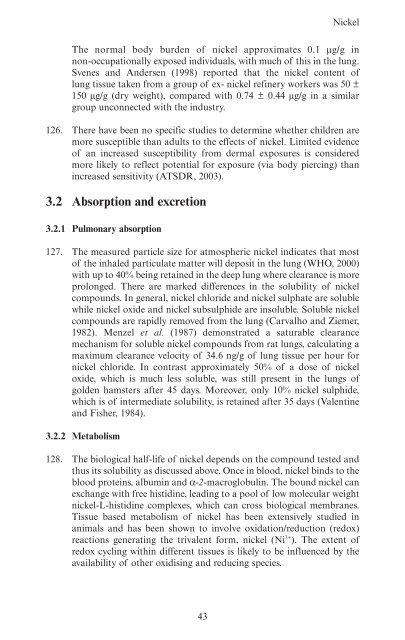Guidelines for Metals and Metalloids in Ambient ... - ARCHIVE: Defra
Guidelines for Metals and Metalloids in Ambient ... - ARCHIVE: Defra
Guidelines for Metals and Metalloids in Ambient ... - ARCHIVE: Defra
You also want an ePaper? Increase the reach of your titles
YUMPU automatically turns print PDFs into web optimized ePapers that Google loves.
Nickel<br />
The normal body burden of nickel approximates 0.1 µg/g <strong>in</strong><br />
non-occupationally exposed <strong>in</strong>dividuals, with much of this <strong>in</strong> the lung.<br />
Svenes <strong>and</strong> Andersen (1998) reported that the nickel content of<br />
lung tissue taken from a group of ex- nickel ref<strong>in</strong>ery workers was 50 ±<br />
150 µg/g (dry weight), compared with 0.74 ± 0.44 µg/g <strong>in</strong> a similar<br />
group unconnected with the <strong>in</strong>dustry.<br />
126. There have been no specific studies to determ<strong>in</strong>e whether children are<br />
more susceptible than adults to the effects of nickel. Limited evidence<br />
of an <strong>in</strong>creased susceptibility from dermal exposures is considered<br />
more likely to reflect potential <strong>for</strong> exposure (via body pierc<strong>in</strong>g) than<br />
<strong>in</strong>creased sensitivity (ATSDR, 2003).<br />
3.2 Absorption <strong>and</strong> excretion<br />
3.2.1 Pulmonary absorption<br />
127. The measured particle size <strong>for</strong> atmospheric nickel <strong>in</strong>dicates that most<br />
of the <strong>in</strong>haled particulate matter will deposit <strong>in</strong> the lung (WHO, 2000)<br />
with up to 40% be<strong>in</strong>g reta<strong>in</strong>ed <strong>in</strong> the deep lung where clearance is more<br />
prolonged. There are marked differences <strong>in</strong> the solubility of nickel<br />
compounds. In general, nickel chloride <strong>and</strong> nickel sulphate are soluble<br />
while nickel oxide <strong>and</strong> nickel subsulphide are <strong>in</strong>soluble. Soluble nickel<br />
compounds are rapidly removed from the lung (Carvalho <strong>and</strong> Ziemer,<br />
1982). Menzel et al. (1987) demonstrated a saturable clearance<br />
mechanism <strong>for</strong> soluble nickel compounds from rat lungs, calculat<strong>in</strong>g a<br />
maximum clearance velocity of 34.6 ng/g of lung tissue per hour <strong>for</strong><br />
nickel chloride. In contrast approximately 50% of a dose of nickel<br />
oxide, which is much less soluble, was still present <strong>in</strong> the lungs of<br />
golden hamsters after 45 days. Moreover, only 10% nickel sulphide,<br />
which is of <strong>in</strong>termediate solubility, is reta<strong>in</strong>ed after 35 days (Valent<strong>in</strong>e<br />
<strong>and</strong> Fisher, 1984).<br />
3.2.2 Metabolism<br />
128. The biological half-life of nickel depends on the compound tested <strong>and</strong><br />
thus its solubility as discussed above. Once <strong>in</strong> blood, nickel b<strong>in</strong>ds to the<br />
blood prote<strong>in</strong>s, album<strong>in</strong> <strong>and</strong> α-2-macroglobul<strong>in</strong>. The bound nickel can<br />
exchange with free histid<strong>in</strong>e, lead<strong>in</strong>g to a pool of low molecular weight<br />
nickel-L-histid<strong>in</strong>e complexes, which can cross biological membranes.<br />
Tissue based metabolism of nickel has been extensively studied <strong>in</strong><br />
animals <strong>and</strong> has been shown to <strong>in</strong>volve oxidation/reduction (redox)<br />
reactions generat<strong>in</strong>g the trivalent <strong>for</strong>m, nickel (Ni 3+ ). The extent of<br />
redox cycl<strong>in</strong>g with<strong>in</strong> different tissues is likely to be <strong>in</strong>fluenced by the<br />
availability of other oxidis<strong>in</strong>g <strong>and</strong> reduc<strong>in</strong>g species.<br />
43
















